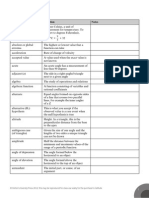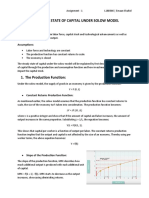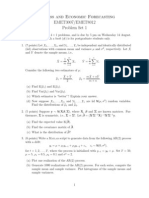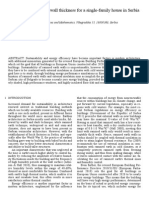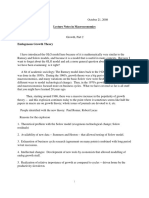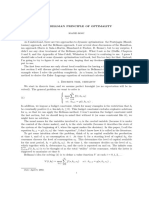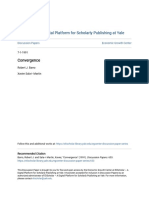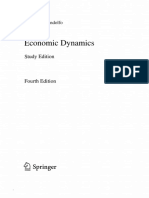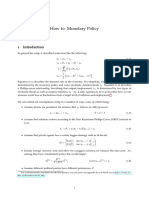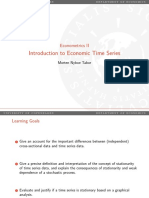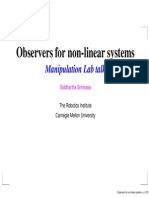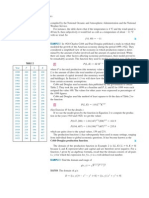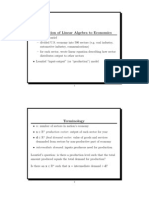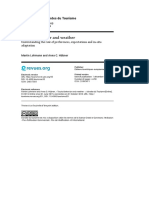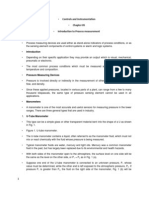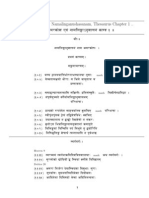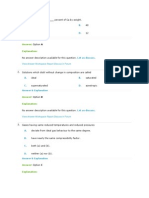Cobb Douglas 2
Cobb Douglas 2
Uploaded by
epsilon9999Copyright:
Available Formats
Cobb Douglas 2
Cobb Douglas 2
Uploaded by
epsilon9999Original Description:
Copyright
Available Formats
Share this document
Did you find this document useful?
Is this content inappropriate?
Copyright:
Available Formats
Cobb Douglas 2
Cobb Douglas 2
Uploaded by
epsilon9999Copyright:
Available Formats
SECTION 11.
3 PARTIAL DERIVATIVES
775
The Cobb-Douglas Production Function
In Example 2 in Section 11.1 we described the work of Cobb and Douglas in modeling the total production P of an economic system as a function of the amount of labor L and the capital investment K. Here we use partial derivatives to show how the particular form of their model follows from certain assumptions they made about the economy. If the production function is denoted by P P L, K , then the partial derivative P L is the rate at which production changes with respect to the amount of labor. Economists call it the marginal production with respect to labor or the marginal productivity of labor. Likewise, the partial derivative P K is the rate of change of production with respect to capital and is called the marginal productivity of capital. In these terms, the assumptions made by Cobb and Douglas can be stated as follows. (i) If either labor or capital vanishes, then so will production. (ii) The marginal productivity of labor is proportional to the amount of production per unit of labor. (iii) The marginal productivity of capital is proportional to the amount of production per unit of capital. Because the production per unit of labor is P L, assumption (ii) says that P L P L
for some constant . If we keep K constant K K0 , then this partial differential equation becomes an ordinary differential equation:
5
dP dL
P L
If we solve this separable differential equation by the methods of Section 7.3 (see also Exercise 67), we get
6
P L, K0
C1 K0 L
Notice that we have written the constant C1 as a function of K0 because it could depend on the value of K0 . Similarly, assumption (iii) says that P K P K
and we can solve this differential equation to get
7
P L 0, K
C2 L 0 K
Comparing Equations 6 and 7, we have
8
P L, K
bL K
776
CHAPTER 11 PARTIAL DERIVATIVES
where b is a constant that is independent of both L and K. Assumption (i) shows that 0 and 0. Notice from Equation 8 that if labor and capital are both increased by a factor m, then P mL, mK b mL mK m bL K m P L, K
If 1, then P mL, mK mP L, K , which means that production is also increased by a factor of m. That is why Cobb and Douglas assumed that 1 and therefore P L, K bL K 1
This is the Cobb-Douglas production function that we discussed in Section 11.1.
11.3
Exercises
1. The temperature T at a location in the Northern Hemisphere
depends on the longitude x, latitude y, and time t, so we can write T f x, y, t . Lets measure time in hours from the beginning of January. (a) What are the meanings of the partial derivatives T x, T y, and T t? (b) Honolulu has longitude 158 W and latitude 21 N. Suppose that at 9:00 A.M. on January 1 the wind is blowing hot air to the northeast, so the air to the west and south is warm and the air to the north and east is cooler. Would you expect fx 158, 21, 9 , fy 158, 21, 9 , and ft 158, 21, 9 to be positive or negative? Explain.
2. At the beginning of this section we discussed the function
(b) In general, what can you say about the signs of I T and I v? (c) What appears to be the value of the following limit? I lim
vl
4. The wave heights h in the open sea depend on the speed v
of the wind and the length of time t that the wind has been blowing at that speed. Values of the function h f v, t are recorded in feet in the following table. Duration (hours) v 10
Wind speed (knots)
5 2 4 5 9 14 19 24
10 2 4 7 13 21 29 37
15 2 5 8 16 25 36 47
20 2 5 8 17 28 40 54
30 2 5 9 18 31 45 62
40 2 5 9 19 33 48 67
50 2 5 9 19 33 50 69
I f T, H , where I is the heat index, T is the temperature, and H is the relative humidity. Use Table 1 to estimate fT 92, 60 and fH 92, 60 . What are the practical interpretations of these values?
3. The wind-chill index I is the perceived temperature when the actual temperature is T and the wind speed is v, so we can write I f T, v . Table 2 (at the bottom of the page) is
15 20 30 40 50 60
an excerpt from a table of values of I compiled by the National Atmospheric and Oceanic Administration. (a) Estimate the values of fT 12, 20 and fv 12, 20 . What are the practical interpretations of these values?
TA B L E 2
Wind speed (km/h)
Actual temperature (C)
T 20 16 12 8
10 18 14 9 5
20 16 11 5 0
30 14 9 3 3
40 13 7 1 5
50 13 7 0 6
60 12 6 0 7
70 12 6 1 7
80 12 5 1 8
90 12 5 1 8
100 12 5 1 8
You might also like
- Homework 1 28 October 2016 SolutionsDocument3 pagesHomework 1 28 October 2016 SolutionsYiğit KocamanNo ratings yet
- Laplace Transform - Aminul Haque, 2224EEE00222Document25 pagesLaplace Transform - Aminul Haque, 2224EEE00222Ãmîñûł Hãqûê AHNo ratings yet
- Midterm Question - Time Series Analysis - UpdatedDocument3 pagesMidterm Question - Time Series Analysis - UpdatedAakriti JainNo ratings yet
- Favar PackageDocument2 pagesFavar PackageTrevor ChimombeNo ratings yet
- Investment Science.Document8 pagesInvestment Science.lizNo ratings yet
- yit = β0 + β1xit,1 + β2xit,2 + β3xit,3 + β4xit,4 + uit ,x ,x ,x ,β ,β ,β ,βDocument10 pagesyit = β0 + β1xit,1 + β2xit,2 + β3xit,3 + β4xit,4 + uit ,x ,x ,x ,β ,β ,β ,βSaad MasoodNo ratings yet
- Glossary of IB MathematicsDocument40 pagesGlossary of IB MathematicsVjti AlumnusNo ratings yet
- The Steady State of Capital Under Solow Model The Solow ModelDocument3 pagesThe Steady State of Capital Under Solow Model The Solow ModelEmaanNo ratings yet
- 8 Ec413 Fiscal Policy 4Document49 pages8 Ec413 Fiscal Policy 46doitNo ratings yet
- Williamson Macroeconomics ch9 Solutions PDFDocument24 pagesWilliamson Macroeconomics ch9 Solutions PDFChandan ChakrabartyNo ratings yet
- Chap 20Document4 pagesChap 20necroteck1No ratings yet
- Business and Economic Forecasting EMET3007/EMET8012 Problem Set 1Document2 pagesBusiness and Economic Forecasting EMET3007/EMET8012 Problem Set 1Ly SopheaNo ratings yet
- A Child's Guide To Dynamic ProgrammingDocument20 pagesA Child's Guide To Dynamic ProgrammingRaffi GarciaNo ratings yet
- Problem Set 5 SolutionDocument17 pagesProblem Set 5 SolutionHarold OngNo ratings yet
- Harvard Economics 2020a Problem Set 4Document4 pagesHarvard Economics 2020a Problem Set 4J100% (1)
- FinalExam Mar21 SolutionsDocument9 pagesFinalExam Mar21 SolutionsHasanul BannaNo ratings yet
- Optimal Rammed Earth Wall Thickness For A Single-Family House in SerbiaDocument5 pagesOptimal Rammed Earth Wall Thickness For A Single-Family House in Serbiadragance106No ratings yet
- Monster Manual - Dark Sun 5th EditionDocument58 pagesMonster Manual - Dark Sun 5th EditionFausto Passarelli100% (4)
- Cobb Douglas ProductionDocument4 pagesCobb Douglas ProductionMim ShakilNo ratings yet
- Weil GrowthDocument72 pagesWeil GrowthJavier Burbano ValenciaNo ratings yet
- Corrected Exercises Topic 4: AnswerDocument17 pagesCorrected Exercises Topic 4: Answerbagdja100% (1)
- 2 Growth Neoclassical GrowthDocument71 pages2 Growth Neoclassical GrowthPAOLA NELLY ROJAS VALERONo ratings yet
- Xppaut NotesDocument8 pagesXppaut Notescalvk79No ratings yet
- Wei Peng Handbook-Of-Quantitative-Finance-And-Risk-Management-2010 - Chap 1Document20 pagesWei Peng Handbook-Of-Quantitative-Finance-And-Risk-Management-2010 - Chap 120222991No ratings yet
- The Solution of Nonlinear Hyperbolic Differential Equations Finite DifferencesDocument13 pagesThe Solution of Nonlinear Hyperbolic Differential Equations Finite Differencesjhonmichael0022No ratings yet
- Macroeconomics 1 PS3 Solution PDFDocument10 pagesMacroeconomics 1 PS3 Solution PDFTaib MuffakNo ratings yet
- Stationarity TS PDFDocument24 pagesStationarity TS PDFJustina SasnauskaiteNo ratings yet
- Econometrics I: TA Session 5: Giovanna UbidaDocument20 pagesEconometrics I: TA Session 5: Giovanna UbidaALAN BUENONo ratings yet
- Full Download of Solution Manual For Advanced Macroeconomics, 5th Edition David Romer in PDF DOCX FormatDocument53 pagesFull Download of Solution Manual For Advanced Macroeconomics, 5th Edition David Romer in PDF DOCX Formatspicaliuu81100% (2)
- Weil 03 ISM C01 Edited PDFDocument3 pagesWeil 03 ISM C01 Edited PDFRyan TanNo ratings yet
- BellmanDocument8 pagesBellmanchiranjeevi kindinla100% (1)
- 20201221203332YWLEE003Perfect Compyp SolutionDocument19 pages20201221203332YWLEE003Perfect Compyp SolutionDương DươngNo ratings yet
- Quiz #9 (CH 11) - Siyao GuanDocument7 pagesQuiz #9 (CH 11) - Siyao Guanbalwantsharma1993No ratings yet
- El Teorema de La Posibilidad de ArrowDocument29 pagesEl Teorema de La Posibilidad de ArrowcientylocoNo ratings yet
- CH 02 Sec 02Document14 pagesCH 02 Sec 02datdude1415No ratings yet
- Chpt2 Text Answers - Stock - Watson - Introduction To EconometricsDocument13 pagesChpt2 Text Answers - Stock - Watson - Introduction To EconometricslswticNo ratings yet
- Exercises PDFDocument30 pagesExercises PDFmylisertaNo ratings yet
- State SpaceDocument20 pagesState SpacepattanayaksuchiNo ratings yet
- MSC Economics Ec413 Macroeconomics: Real Business Cycles IiDocument21 pagesMSC Economics Ec413 Macroeconomics: Real Business Cycles Iikokibonilla123No ratings yet
- CES Prodn FNDocument4 pagesCES Prodn FNspmisraNo ratings yet
- Barro, Sala I Martin - 1992Document47 pagesBarro, Sala I Martin - 1992L Laura Bernal HernándezNo ratings yet
- Solutions - PS5 (DAE)Document23 pagesSolutions - PS5 (DAE)icisanmanNo ratings yet
- Gandolfo Cap 11 EdDocument9 pagesGandolfo Cap 11 EdMiguel S OrdoñezNo ratings yet
- Financial Econometrics and Empirical Finance - Module 2 General Exam Solutions - July 2012Document25 pagesFinancial Econometrics and Empirical Finance - Module 2 General Exam Solutions - July 2012Sunny DeolNo ratings yet
- EC310 Lecture Slides 2018Document119 pagesEC310 Lecture Slides 2018NLNo ratings yet
- Gujarati D, Porter D, 2008: Basic Econometrics 5Th Edition Summary of Chapter 3-5Document64 pagesGujarati D, Porter D, 2008: Basic Econometrics 5Th Edition Summary of Chapter 3-5PrincessNo ratings yet
- Introducing Advanced Macroeconomics:: Growth and Business Cycles CyclesDocument28 pagesIntroducing Advanced Macroeconomics:: Growth and Business Cycles CyclesIzzat MushtaqNo ratings yet
- The Application of Derivatives To The Concepts of Marginal CostDocument4 pagesThe Application of Derivatives To The Concepts of Marginal CostLuke ShawNo ratings yet
- Monetary Policy - NotesDocument12 pagesMonetary Policy - NotesPedroNo ratings yet
- Macroeconomics 1 Problem Set 8 Solution PDFDocument5 pagesMacroeconomics 1 Problem Set 8 Solution PDFTaib MuffakNo ratings yet
- Introduction To Optimal Control Theory and Hamilton-Jacobi EquationsDocument55 pagesIntroduction To Optimal Control Theory and Hamilton-Jacobi EquationsPREETISH VIJ100% (1)
- 01A Introduction To Economic Time SeriesDocument26 pages01A Introduction To Economic Time SeriesFaizus Saquib ChowdhuryNo ratings yet
- The Cobb-Douglas Production FunctionDocument42 pagesThe Cobb-Douglas Production Functionkathuriatanu100% (1)
- Growth Accounting Exercise PDFDocument2 pagesGrowth Accounting Exercise PDFTaib MuffakNo ratings yet
- 05 GMM (Annotated)Document106 pages05 GMM (Annotated)Widya RezaNo ratings yet
- ML: Introduction 1. What Is Machine Learning?Document38 pagesML: Introduction 1. What Is Machine Learning?rohitNo ratings yet
- 1 Prebisch-SingerDocument43 pages1 Prebisch-SingerFrancis PerezNo ratings yet
- Ps2answers PDFDocument10 pagesPs2answers PDFkeyyongparkNo ratings yet
- Observers For Non-Linear SystemsDocument35 pagesObservers For Non-Linear SystemsdvnccbmacbtNo ratings yet
- Tunneling Through A Potential BarrierDocument11 pagesTunneling Through A Potential BarrierGregory HillhouseNo ratings yet
- 14 Partial Derivatives 2Document23 pages14 Partial Derivatives 2Thanh Thiên Phúc NguyễnNo ratings yet
- Cob Douglas Production TheoryDocument7 pagesCob Douglas Production Theoryamkumar1975No ratings yet
- Derivadas ParcialesDocument4 pagesDerivadas ParcialesDaren GuerreroNo ratings yet
- Cobb Douglas 1Document1 pageCobb Douglas 1epsilon9999No ratings yet
- Chapter 03Document78 pagesChapter 03orfeas11No ratings yet
- PPL2Document14 pagesPPL2epsilon9999No ratings yet
- Leontief 2Document6 pagesLeontief 2epsilon9999No ratings yet
- The Effectiveness of Using PerlitefiltroperliteDocument7 pagesThe Effectiveness of Using PerlitefiltroperlitejarealNo ratings yet
- Airport Characteristics 07 PostedDocument20 pagesAirport Characteristics 07 PostedernycueaNo ratings yet
- Scholarship Test For Class 8th-4Document9 pagesScholarship Test For Class 8th-4pchikhalkar11No ratings yet
- Tourist Behavior and Weather: Mondes Du TourismeDocument17 pagesTourist Behavior and Weather: Mondes Du TourismeΣοφία ΝικολάουNo ratings yet
- 07 July 1998Document100 pages07 July 1998Monitoring Times100% (1)
- Ubd ModuleDocument9 pagesUbd Moduleapi-468552757No ratings yet
- Peter Pan New Story ObookoDocument153 pagesPeter Pan New Story ObookophillipNo ratings yet
- English GrammarDocument157 pagesEnglish GrammarJd Recio100% (2)
- Genz 2019Document184 pagesGenz 2019Mrityunjoy BanerjeeNo ratings yet
- Northgreenland UkDocument16 pagesNorthgreenland UkmnutarelliNo ratings yet
- Project Overview Doc in Light Green Blue Vibrant Professional StyleDocument3 pagesProject Overview Doc in Light Green Blue Vibrant Professional StyleKedibone MphethiNo ratings yet
- Chapter 85 Controls and InstrumentationDocument21 pagesChapter 85 Controls and InstrumentationJasmine ArmstrongNo ratings yet
- API 650 Datasheet 1Document16 pagesAPI 650 Datasheet 1alwacsNo ratings yet
- 11 KlasiDocument3 pages11 KlasiMarexi SakvarelashviliNo ratings yet
- Amar KoshDocument26 pagesAmar KoshxbabaxNo ratings yet
- Passive Design: - Yash Jhawar B.Arch (XTH Sem) P.I.A.D.SDocument25 pagesPassive Design: - Yash Jhawar B.Arch (XTH Sem) P.I.A.D.SyjhawarNo ratings yet
- Story of Miko The MonkeyDocument6 pagesStory of Miko The MonkeyMadara SalmaneNo ratings yet
- Rfactor Calculation InstructionsDocument6 pagesRfactor Calculation InstructionsACTRNo ratings yet
- S.1 GeogDocument2 pagesS.1 GeogMulangira Mulangira100% (1)
- MARS209 - Freewater in CargoDocument4 pagesMARS209 - Freewater in Cargoc rkNo ratings yet
- 4799e SabbDocument2 pages4799e SabbLazzarus Az GunawanNo ratings yet
- Section 1Document20 pagesSection 1HAFIZ IMRAN AKHTERNo ratings yet
- Connection Elf Satellites Haarp AerosolsDocument260 pagesConnection Elf Satellites Haarp AerosolsJose LuizNo ratings yet
- 4594 Malaysia IC-CFS Project Document 07-01-2014 (Final Prodoc)Document227 pages4594 Malaysia IC-CFS Project Document 07-01-2014 (Final Prodoc)Ridzuan NainaNo ratings yet
- Catalogo Bernavi - eDocument5 pagesCatalogo Bernavi - eCarlos GrandeNo ratings yet
- Adverb Clause of TimeDocument11 pagesAdverb Clause of TimenadhiarthaNo ratings yet
- Flow Chart of Proto Sample Development in Apparel IndustryDocument22 pagesFlow Chart of Proto Sample Development in Apparel Industrysabber100% (1)






